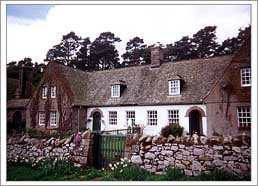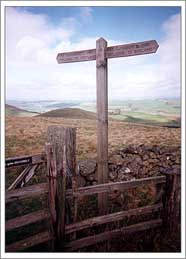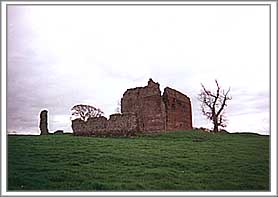Outdoors: Cycling, Walking and Hillclimbing

I have always wanted to visit Lindisfarne and when the opportunity came up to walk the sixty two miles from Melrose to Lindisfarne crossing from Scotland to England following in St. Cuthbert's footsteps, I immediately put my name down for the Charity Sponsored walk in aid of the SSPCA(Scottish Society for the Prevention of Cruelty to Animals) over an Easter weekend.
Twenty six of us assembled at Melrose to start the four day walk. Most of us were complete strangers but we soon gelled as a Group and had some fun along the way. Whatever would have St. Cuthbert said about all this merriment on the Pilgrim's Way?
St. Cuthbert was a native of the border country who received his calling aged 16 in 875AD.. From that day till his death he served the Church finally achieving the rank of Bishop. He was beatified, some 11 years after his death, when his coffin was opened and his remains found to be perfectly preserved. These remains were removed from Holy Island (Lindisfarne) when the island community was threatened by Viking raids, and finally came to rest in Durham Cathedral.
The route of St Cuthbert's Way is fascinating following proven rights of way and will unfold as I describe the walk over the four days . Our merry bunch left Melrose Abbey, where St. Cuthbert began his ministry, in fine weather and climbed into the Eildon Hills stopping for tea at a little teashop which had agreed to donate a percentage of it's takings to the SSPCA. One man carried his little daughter Ruth, aged two and a half, the entire route on a back carrier with an average of 17 miles a day walking. Rurh was so good in her carrier and now and again would get out and run around in her little wellington boots.
The route was extremely muddy as there had been heavy rain during the previous week. The Eildon Hills remained in our view for most of the walk. After Newtown St Boswells there was a lovely walk alongside the River Tweed where there was a profusion of wild garlic alongside the path and a view over to Dryburgh Abbey. This was lovely soft countryside unlike some of the harsh landscapes encountered when Munro bagging. It was early Spring and there were masses of daffodils in the many clearings in the woodlands we wandered through before we reached Dere Street, which is a Roman Road and built in a straight line regardless of the terrain it passes over which is usually hilly. There are no remains of the street but only the route it follows.
We were expecting a good cobbled street but were disappointed to find it was a muddy farm track! We ended our first day at Harestanes Visitors Centre where the heavens opened and we were deluged with rain but that did not dampen our spirits as the bus picked us up and drove us back to our accomodation in Melrose for an excellent meal and a few drams.

The second day the bus returned us to Harestanes on a very mild day and we continued on Dere Street over Ancrum Moor, crossing the River Teviot by a new wooden pedestrian suspension bridge. We continued on a very muddy Dere Street passing the ruined Cessford Castle and on to Morebattle. Most of us were well equipped and wore gaiters which were invaluable in keeping the mud out of our boots. I am assured the route is not always muddy and I have spoken to other walkers who did not have any mud on their walk. After Morebattle, it was into the hills again and the highest ascent of 1,300 feet at Wideopen Hill. This was aptly named as it had open views around the Border Countryside. It was on then to Kirk Yetholm and a well deserved pint on the picturesque village green from a very old pub. The bus picked us up and we travelled to Wooler over the border to spend two nights. I stayed in the Youth Hostel but some other walkers stayed at a Bed and Breakfast which they praised very highly (Humph and Dave - telephone 01688 281497). We passed the evening in the time honoured tradition of a nice meal and a few drinks at the local hostelry.

By the third day there were sore feet all around and the leader did a wonderful job of applying the appropriate dressings to the blisters! We returned to Kirk Yetholm aand as it was Easter Sunday the organisers acted as Easter Bunnies and gave out Easter Eggs which was a nice gesture. Today was exciting as we crossed the border for Scotland to England on the Cheviot Hills very near to the end of the Pennine Way. There was a gate and direction markers to identify the border and the site of a Roman Fort could be clearly seen on an adjacent hill. This border was not always as calm as present and Ancrum Moor mentioned on yesterday's route is the site of a battle between the warring Scots and the English. There is also the Wallace Statue nearby, erected in1814 and dedicated to William Wallace, the scourge of the English After passing Green Humbleton, we stopped for lunch across from a row of delightful cottages at Hethpool which were unfortunately marred by a very large satellite dish in the front garden. Whenever we stopped for a break, one of the minibuses would magically appear to give out bottles of water and chocolate bars. Well done to Ian Glassey, the organiser! On today's walk we saw grouse and pheasant on the moors and many new lambs in the fields including a set of triplets. In the evening at Wooler we had a formal dinner with fine wine at a hotel as it was our last night together as a group. Afterwards, we walked back to the hostel in a spectacular thunderstorm with heavy rain which fortunately had cleared by the next morning.
On the final day, it was a beautiful sunny morning and we made our way to Westwood Bridge and over hills and dales to St. Cuthbert's Cave where his remains were stored for 200 years after he died. The cave is of a reasonable size and within a clearing in the woodlands. We made our way onwards as we had to cross the sandflats to Holy Island before the tide came in . Holy Island is cut off from the mainland at high tide and the causeway can only be crossed at low tide. Now comes my only complaints about the route. The main east coast railway line to London and the A1 road have to be crossed. Thumbs down to Berwick-on-Tweed Council for not providing footbridges. It is difficult to see along the railway line from the embankment and very frightening when an inter city train thunders towards you at very high speed. Despite writing to the Council twice on this matter, they have not given me the courtesy of a reply. Contact me at helenrose52@hotmail.com if you share my concerns on the lack of footbridges and can help to encourage the Council to resolve the problem. The final stretch of the walk was along the sand dunes on the Northumberland coast and across the Roman Road on the sand to Holy Island marked by large wooden poles. Some of the group followed the example of the early pilgrims and walked barefoot across the sand but this may hve been more to do with having sore feet in their boots rather than for religious reasons!
When we reached Holy Island , we were disappointed to find it was very touristy and busy but we felt a tremendous sense of achievement having walked sixty two and a half miles in four days on a route rich in history and with stunning views. I recommend you walk the route before everyone discovers it and it becomes very crowded.
As I am currently touring South America, Pat will put the February instalment on Everest Base Camp on the Website.
Contact me at helenrose52@hotmail.com with your news and views and any ideas for future instalments of Munros. I still have 135 Munros to do but hope to tick off a good few in 2001!
Thanks to Frances Rickus for photographs.







